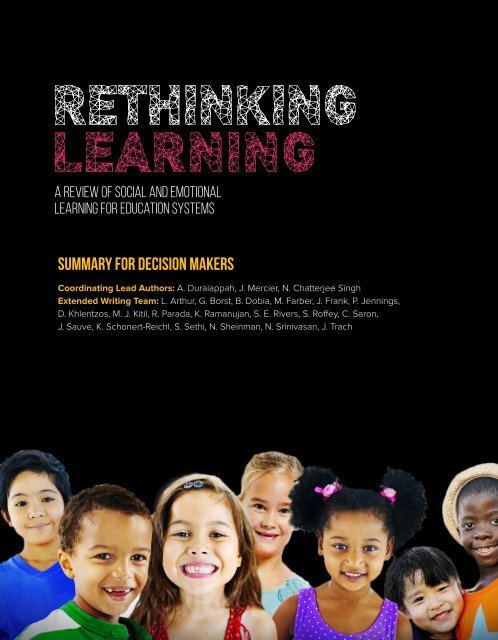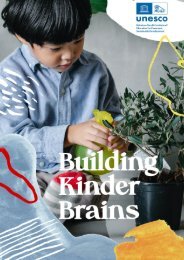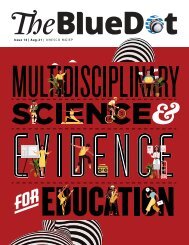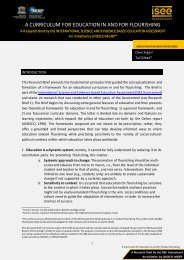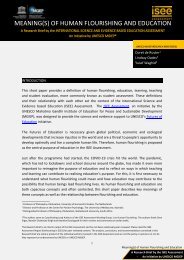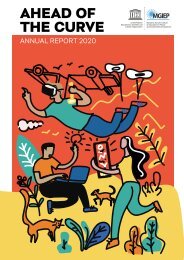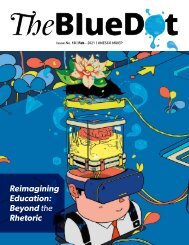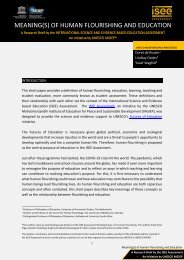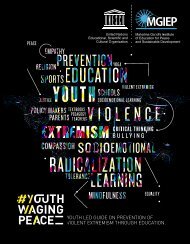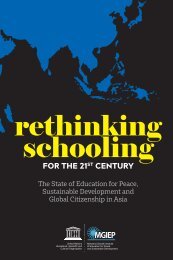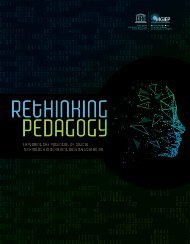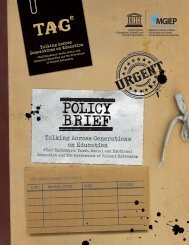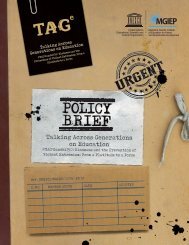Rethinking Learning: Summary for Decision Makers
This publication reviews the latest research on Social and Emotional Learning (SEL), its impact on student health and school climate and its transformative role in building happier classrooms. It seeks to inform and impress upon Member States the urgent need to mainstream social and emotional learning in education systems.
This publication reviews the latest research on Social and Emotional Learning (SEL), its impact on student health and school climate and its transformative role in building happier classrooms. It seeks to inform and impress upon Member States the urgent need to mainstream social and emotional learning in education systems.
You also want an ePaper? Increase the reach of your titles
YUMPU automatically turns print PDFs into web optimized ePapers that Google loves.
<strong>Summary</strong> <strong>for</strong><br />
<strong>Decision</strong> <strong>Makers</strong><br />
Introduction Chapter 1 Chapter 2 Chapter 3 Chapter 4 Chapter 5 Chapter 6 Chapter 7 Chapter 8<br />
RETHINKING<br />
LEARNING<br />
A Review of Social and Emotional<br />
<strong>Learning</strong> <strong>for</strong> Education Systems<br />
<strong>Summary</strong> <strong>for</strong> <strong>Decision</strong> <strong>Makers</strong><br />
Coordinating Lead Authors: A. Duraiappah, J. Mercier, N. Chatterjee Singh<br />
Extended Writing Team: L. Arthur, G. Borst, B. Dobia, M. Farber, J. Frank, P. Jennings,<br />
D. Khlentzos, M. J. Kitil, R. Parada, K. Ramanujan, S. E. Rivers, S. Roffey, C. Saron,<br />
J. Sauve, K. Schonert-Reichl, S. Sethi, N. Sheinman, N. Srinivasan, J. Trach<br />
xxiii
<strong>Summary</strong> <strong>for</strong><br />
<strong>Decision</strong> <strong>Makers</strong><br />
Introduction Chapter 1 Chapter 2 Chapter 3 Chapter 4 Chapter 5 Chapter 6 Chapter 7 Chapter 8<br />
xxiv
<strong>Summary</strong> <strong>for</strong><br />
<strong>Decision</strong> <strong>Makers</strong><br />
Introduction Chapter 1 Chapter 2 Chapter 3 Chapter 4 Chapter 5 Chapter 6 Chapter 7 Chapter 8<br />
The 1996 UNESCO report, “<strong>Learning</strong>: the Treasure Within; Report to UNESCO of the International<br />
Commission on Education <strong>for</strong> the Twenty-first Century”, unequivocally stressed that while<br />
education is an ongoing process of improving knowledge and skills, it is also – perhaps, primarily<br />
– an exceptional means of bringing about personal development and building relationships<br />
among individuals, groups and nations.<br />
The publication, titled “<strong>Rethinking</strong> <strong>Learning</strong>: A Review of Social and<br />
Emotional <strong>Learning</strong> (SEL) <strong>for</strong> Education Systems” was worked upon<br />
from 2018 to 2020. The purpose of this publication was to review<br />
the latest research on SEL and to present scientific evidence <strong>for</strong><br />
why SEL is key to education, and by that corollary, to achieving<br />
the United Nations (UN) Sustainable Development Goals<br />
(SDGs), specifically SDG 4, Target 7 that focuses on building<br />
peaceful and sustainable societies through education. Some key<br />
points that emerged with regard to SEL are enumerated below.<br />
FIRST, we must acknowledge that humans are complex social<br />
and emotional beings whose well-being depends on learning to<br />
communicate their needs to each other effectively and managing their<br />
emotions in healthy ways. These needs and capabilities are universal – every human brain<br />
develops to enable social and emotional skills such as empathy, compassion and perspectivetaking.<br />
Empathy is the general capacity of individuals to recognise emotion and to also resonate<br />
with others’ emotional states such as happiness, excitement, sorrow, or fear (Baird, Scheffer and<br />
Wilson, 2011). Perspective taking may be described as the ability to consider others’ points of<br />
view and requires some understanding of others’ thoughts, feelings, motivations, and intentions.<br />
Compassion is the ability to take positive action to alleviate suffering in the other and requires<br />
behavioural action motivated by the need and desire to improve the other’s well-being (Klimecki<br />
et al., 2012). The development of these skills may be hampered by difficult life circumstances and<br />
contexts or conversely, nurtured by an appropriate social environment.<br />
SECOND, research in social cognition and human neuroscience has enhanced our<br />
understanding of the origins of violence and hatred, and has also uncovered the processes<br />
that facilitate the construction of behaviour and conceptions promoting peace. For instance,<br />
research in psychology and neuroscience has revealed that hatred, bullying, violence and<br />
intercommunal hate are all driven by perceptions of threat, alienation and negative emotion, and<br />
have neurobiological origins in aggression (Falkner et al., 2016; Sapolsky, 2017).<br />
THIRD, research from the neurosciences has also shown that these biological roots of rage<br />
and aggression can be trained using behavioural tools of SEL, and redirected towards peaceful<br />
and constructive action. This retraining of brain circuits happens because of a remarkable<br />
xxv
<strong>Summary</strong> <strong>for</strong><br />
<strong>Decision</strong> <strong>Makers</strong><br />
Introduction Chapter 1 Chapter 2 Chapter 3 Chapter 4 Chapter 5 Chapter 6 Chapter 7 Chapter 8<br />
process called neuroplasticity, which is the ability of the brain to rewire itself by repeated training<br />
and practice. Specifically, building competencies of attention regulation through programmes<br />
on mindfulness (Davidson et al., 2003) and emotional regulation – which build positive peer<br />
relationships (Obsuth et al., 2015), and compassion – has been shown to regulate and reduce<br />
aggression and violence, and promote peaceful and prosocial behaviour.<br />
FOURTH, in addition to the rise in intolerance, violence and extremism (Institute <strong>for</strong> Economics<br />
and Peace, 2019), a recent study conducted by WHO (World Health Organization, 2017) also<br />
reports an increase in anxiety, stress and depression in youth.<br />
For instance, in India alone, about 25% of children between the ages of 13 and 15 suffer from<br />
some <strong>for</strong>m of depression or anxiety. The highly competitive nature of the present education<br />
system, the growing uncertainty of the employment market and the types of jobs that will be in<br />
demand in the future have been mentioned as some of the major causes <strong>for</strong> the growing levels<br />
of stress and anxiety.<br />
FIFTH, at the same time, research from the learning sciences tells us that the same knowledge<br />
and behaviours that contribute towards reduced aggression, violence, anxiety, fear and anger<br />
also contribute towards improved academic success. The competencies of attention regulation<br />
and emotional regulation improve with such knowledge, leading to improvement in learning.<br />
SIXTH, the key findings summarised above indicate that the introduction of SEL can in fact<br />
provide a double dividend to learners and the society in the <strong>for</strong>m of improving academic<br />
achievements and also nurturing empathic and compassionate individuals dedicated to building<br />
peaceful and sustainable societies across the world.<br />
SEVENTH, it is thus urgent and necessary that this new knowledge and<br />
understanding be mainstreamed into education systems to trans<strong>for</strong>m the<br />
systems with the purpose of shaping a future that embraces and facilitates<br />
improved academic success as well as peace and human<br />
flourishing.<br />
This summary, aimed at decision makers, synthesises<br />
and integrates the main findings, challenges and<br />
recommendations from the eight chapters of the full<br />
Review. The key questions that guided the Review were: (i)<br />
What constitutes an SEL intervention; (ii) Why and when SEL<br />
interventions are necessary; (iii) The science and evidence<br />
supporting SEL interventions; (iv) How can SEL be implemented;<br />
and (iv) The cost and benefits of SEL interventions.<br />
xxvi
<strong>Summary</strong> <strong>for</strong><br />
<strong>Decision</strong> <strong>Makers</strong><br />
Introduction Chapter 1 Chapter 2 Chapter 3 Chapter 4 Chapter 5 Chapter 6 Chapter 7 Chapter 8<br />
The key questions that guided the Report were: (i) What<br />
constitutes an SEL intervention; (ii) Why and when SEL<br />
interventions are necessary; (iii) The science and evidence<br />
supporting SEL interventions; (iv) How can SEL be implemented;<br />
and (iv) The cost and benefits of SEL interventions.<br />
What is SEL?<br />
SEL can be broadly defined as the process of acquiring the competencies, skills and/or attitudes<br />
to recognise and manage emotions, develop caring and concern <strong>for</strong> others, establish positive<br />
relationships, make responsible decisions and handle challenging situations (Payton et al., 2000;<br />
Greenberg et al., 2003; Weissberg et al., 2015).<br />
Key Message 1<br />
The key components of an SEL framework should include critical inquiry,<br />
focus attention, regulate emotion and cultivate compassionate action<br />
to produce a balance of intrapersonal, interpersonal and cognitive<br />
competencies while always ensuring that these frameworks are grounded in<br />
empirical evidence.<br />
For instance, SEL focuses on the skills that allow children to calm themselves when angry, make<br />
friends, resolve conflicts respectfully, and make ethical and safe choices.<br />
SEL emphasises active learning approaches in which skills can be generalised across curriculum<br />
areas and contexts when opportunities are provided to practice the skills that foster positive<br />
attitudes, behaviours and thinking processes. The popularity of this construct is due, in part, to<br />
the increased recognition that the key to prevention and intervention ef<strong>for</strong>ts is the identification<br />
of factors that lead to success rather than to just those factors that reduce risk. It is important to<br />
recast our priorities in terms of facilitating positive adjustment among children and youth, rather<br />
than only limiting risk, as well as extending our focus to all children and youth, instead of only<br />
those exhibiting risk factors.<br />
Today, SEL has been characterised in a variety of ways, often being used as an organising<br />
framework <strong>for</strong> an array of promotion and prevention ef<strong>for</strong>ts in education and developmental<br />
science, including conflict resolution, cooperative learning, bullying prevention, mental health<br />
promotion and positive youth development (Elias et al., 1997; Devaney et al., 2006).<br />
xxvii
<strong>Summary</strong> <strong>for</strong><br />
<strong>Decision</strong> <strong>Makers</strong><br />
Introduction Chapter 1 Chapter 2 Chapter 3 Chapter 4 Chapter 5 Chapter 6 Chapter 7 Chapter 8<br />
Why is SEL Needed in Education?<br />
Humans are social beings and possess an innate, biologically-driven ability to develop and <strong>for</strong>m<br />
interpersonal connections. These social bonds, <strong>for</strong>med early in life, also create the foundation <strong>for</strong><br />
human beings to coexist in and across groups, and are a vital part of the human experience.<br />
Key Message 2<br />
Humans are born with an innate capacity <strong>for</strong> <strong>for</strong>ming social connections.<br />
Humans need social and emotional connections <strong>for</strong> learning and higherorder<br />
cognition. <strong>Learning</strong> is facilitated or hindered by the social and<br />
emotional experiences of the learner. There<strong>for</strong>e, an individual’s emotional<br />
and social development is as important as the individual’s cognitive and<br />
biological development. Education systems must be able to address and<br />
contribute to this aspect of human experience.<br />
Thus, in addition to contributing to physical and psychological development, social connections<br />
also <strong>for</strong>m the basis <strong>for</strong> human cognition and learning. <strong>Learning</strong> is facilitated or hindered by the<br />
social and emotional experiences of the learner, which help guide attention during learning,<br />
assist in in<strong>for</strong>mation encoding and retrieval from memory, and effectively manage the social<br />
interactions and relationships that are fundamental to the learning process (Immordino-Yang and<br />
Damasio, 2007).<br />
Key Message 3<br />
A growing body of scientific research indicates that students’ social and<br />
emotional competence not only predicts their school success, but also<br />
predicts a range of important outcomes in late adolescence and adulthood,<br />
including high school graduation, postsecondary completion, employment,<br />
financial stability, physical health, and overall mental health and well-being.<br />
The aspects of cognition that are recruited most heavily in education, including learning,<br />
attention, memory, decision making, motivation, and social functioning, are both profoundly<br />
affected by emotion and are in fact subsumed within the processes of emotion. Hence, how we<br />
feel affects how and what we learn.<br />
There<strong>for</strong>e, a school curriculum that ignores children’s emotional, social or physical needs will<br />
find that those unmet needs will work against achieving cognitive and academic goals (Diamond,<br />
2014). Whether it is acquiring the skills of literacy and numeracy in childhood or more intellectual<br />
content in the adolescent years, social and emotional competence provides a stable and secure<br />
state <strong>for</strong> the brain to learn.<br />
xxviii
<strong>Summary</strong> <strong>for</strong><br />
<strong>Decision</strong> <strong>Makers</strong><br />
Introduction Chapter 1 Chapter 2 Chapter 3 Chapter 4 Chapter 5 Chapter 6 Chapter 7 Chapter 8<br />
Research on various populations has repeatedly shown that SEL can be learned and is durable.<br />
Studies show that students who received an SEL intervention continued to show increases in<br />
social and emotional skills, positive behaviours and academic achievement, and decreases in<br />
conduct problems, emotional distress, and drug use up to almost four years after programme<br />
completion, in contrast to those students who did not receive an SEL intervention.<br />
Key Message 4<br />
There is a confluence of research from multiple studies showing that<br />
students who participate in SEL programmes, relative to students who do<br />
not, demonstrate significantly improved social and emotional competencies,<br />
attitudes, and behavioural adjustment. In addition they also outper<strong>for</strong>med<br />
those students who did not participate in SEL programmes, on indices<br />
of academic achievement by 11-percentile points. Using extrapolative<br />
methods, preliminary results using data from over 60 countries suggests<br />
that the productivity lost <strong>for</strong> not spending on SEL interventions is about 29%<br />
of the Gross National Income.<br />
What is the Science behind SEL?<br />
All learning occurs in a context involving social interactions,<br />
and triggers emotions and feelings in the learner. This is<br />
reflected in the brain by the involvement of key structures<br />
of the social and emotional brain, when children and<br />
adolescents learn to read, count, reason and also make<br />
decisions.<br />
The human brain is not static; it develops throughout the<br />
lifetime of the individual, especially when adaptation to the<br />
environment is necessary. All mental activities are supported by hierarchical, distributed and<br />
integrated systems in the brain. From early childhood and even be<strong>for</strong>e birth, brain development<br />
is influenced by the social and the emotional environment to which a child is exposed (Farah,<br />
2017).<br />
At all ages of a human’s existence, the brain has the unique ability to adapt to the demands of<br />
the environment (irrespective of its nurturing or toxic nature) by changing its functioning and its<br />
wiring. This is especially critical during periods of extreme sensitivity to the environment, namely<br />
early childhood and adolescence. The plasticity of the brain offers incredible opportunity <strong>for</strong><br />
learning but also translates into responsibility <strong>for</strong> parents, teachers and policy decision makers.<br />
xxix
<strong>Summary</strong> <strong>for</strong><br />
<strong>Decision</strong> <strong>Makers</strong><br />
Introduction Chapter 1 Chapter 2 Chapter 3 Chapter 4 Chapter 5 Chapter 6 Chapter 7 Chapter 8<br />
Key Message 5<br />
Early childhood and adolescence constitute periods of maximal sensitivity<br />
of the brain to experience and to the environment. However, brain<br />
development, cognitive and social and emotional development are<br />
dynamic and non-linear. There<strong>for</strong>e, enriched social environments and<br />
social interactions have a positive effect on brain maturation as well as on<br />
cognitive and social and emotional development at all ages.<br />
The brain is definitely more ‘plastic’ (that is, it is more amenable to change) till the age of 24,<br />
which is considered to be the most sensitive period. We also know, however, that neuroplasticity<br />
can manifest at any age from intense and prolonged learning or during dramatic changes in the<br />
environment. Just as brain maturation is non-linear and dynamic, the cognitive and social and<br />
emotional aspects are also not linear in their development of children and adolescents.<br />
Development should thus be conceived of as a non-linear dynamic system, consistently shaped<br />
by the environment and experience. Errors in learning or difficulties are not age-dependent, but<br />
are context-dependent. In particular, difficulties in learning occur at any age and in any context<br />
when children, adolescents or adults rely on automatic (pre-potent) responses, misleading<br />
strategies, cognitive and social and emotional heuristics rather than on deliberate, well-thought<br />
out strategies and responses adapted to the context. SEL competencies train the brain to<br />
develop deliberate response strategies that are socially relevant and emotionally resilient in<br />
design and structure.<br />
Social interactions rely, also in part, on understanding and<br />
attributing mental states to others, the so-called Theory of<br />
Mind (ToM). ToM typically allows one to understand, think and<br />
reason about the beliefs and thoughts of others (Frith and<br />
Frith, 2005). A large network of areas in the brain sustain ToM<br />
abilities; these areas include the superior temporal sulcus<br />
(STS), fusi<strong>for</strong>m gyrus (FG), temporal pole (TP), medial prefrontal<br />
cortex (mPFC), frontal pole (FP), orbitofrontal cortex (OFC),<br />
amygdala, insula, temporoparietal junction (TPG) and cingulate<br />
cortex (Figure 1).<br />
ToM abilities develop rapidly through preschool years but<br />
follow a protracted development through late childhood and<br />
into mid-adolescence, paralleling the structural maturation<br />
observed in the ‘social brain’ (Adolphs, 2009). Importantly,<br />
ToM is not restricted to reasoning about others’ mental states<br />
xxx
<strong>Summary</strong> <strong>for</strong><br />
<strong>Decision</strong> <strong>Makers</strong><br />
Introduction Chapter 1 Chapter 2 Chapter 3 Chapter 4 Chapter 5 Chapter 6 Chapter 7 Chapter 8<br />
but also about their affective states. ToM and empathy differ essentially by their degree of<br />
embodiment – ToM involves propositional knowledge of another’s mental or affective state,<br />
while empathy involves sensory, affective or bodily state sharing.<br />
Other prosocial behaviours elicit activations of different structures of the social brain. For<br />
instance, charity activates the striatum, a subcortical structure of the brain involved in the reward<br />
system and the ventromedial prefrontal cortex (bottom part of the mPFC). Altruistic behaviours<br />
rely on the superior temporal sulcus and cooperation on the medial prefrontal cortex (Figure 1).<br />
Figure 1: Key regions of the social brain<br />
[Adapted from Patrick J. Lynch, medical illustrator; C. Carl Jaffe, MD, cardiologist.<br />
https://creativecommons.org/licenses/by/2.5]<br />
To summarize, rather than being governed by a specific part of the brain, higher order socialpsychological<br />
phenomena (e.g., self-control at the individual level, and empathy, altruism<br />
and compassion at the inter-individual level) are the result of a collection of skills hinging on<br />
interactions between multiple neurological networks that involve multiple areas of the brain<br />
(Beckes and Coan, 2015; Eisenberg, Spinrad and Knafo-Noam, 2015; Di and Biswal, 2019).<br />
Finally, findings from brain science cannot be prescriptive of education policies but education<br />
policies that adhere to the principles of the learning mechanisms involving the brain, knowledge<br />
and behaviours, along with the accompanying social and emotional facets, are more likely to be<br />
effective (Immordino-Yang and Gotlieb, 2017). More precisely, educators who have knowledge<br />
of the cognitive, affective and developmental processes underlying academic learning are more<br />
likely to design interventions that are optimally tailored to children’s needs.<br />
xxxi
<strong>Summary</strong> <strong>for</strong><br />
<strong>Decision</strong> <strong>Makers</strong><br />
Introduction Chapter 1 Chapter 2 Chapter 3 Chapter 4 Chapter 5 Chapter 6 Chapter 7 Chapter 8<br />
What are SEL Competencies and Frameworks?<br />
Identifying and selecting an SEL framework <strong>for</strong> implementation in education is a critical first step<br />
because a framework ideally lays out the theoretical context underpinning the suite of social and<br />
emotional competencies that students would need to be successful in school, life and work. The<br />
education sector is presently replete with SEL frameworks due to the growing popularity and<br />
acknowledgement of SEL’s potential to address the academic and social issues challenges that<br />
learners face today.<br />
A study conducted in 2017 identified 136 frameworks across 14 areas of study, including Positive<br />
Youth Development, Resilience, Character Education, School-Based Competency Development,<br />
Public Health, Mental Health and Mindfulness. One central finding that emerged was that “…<br />
different terms are used <strong>for</strong> competencies that have similar definitions, and that the same terms<br />
are used <strong>for</strong> competencies that have different definitions” (Berg et al., 2017). Conceptual clarity is<br />
there<strong>for</strong>e a key necessity when using any SEL framework.<br />
Examples of some key SEL frameworks are:<br />
1. Collaborative <strong>for</strong> Academic, Social and Emotional <strong>Learning</strong>. CASEL:<br />
Figure 2: CASEL’s Five SEL Competencies<br />
Home and Communities<br />
Schools<br />
Classrooms<br />
SELF-<br />
AWARENESS<br />
SOCIAL<br />
AWARENESS<br />
SELF-<br />
MANAGEMENT<br />
RESPONSIBLE<br />
DECISION-<br />
MAKING<br />
RELATIONSHIP<br />
SKILLS<br />
SEL Curriculum and Introduction<br />
Schoolwide Practices and Policies<br />
Family and Community Partnerships<br />
[Source: CASEL, ©2017. All rights reserved. https://casel.org/core-competencies”]<br />
xxxii
<strong>Summary</strong> <strong>for</strong><br />
<strong>Decision</strong> <strong>Makers</strong><br />
Introduction Chapter 1 Chapter 2 Chapter 3 Chapter 4 Chapter 5 Chapter 6 Chapter 7 Chapter 8<br />
2. Social, Emotional, Academic Development. SEAD:<br />
Figure 3: Three Groups of SEL Competencies<br />
COGNITIVE SOCIAL & INTERPERSONAL EMOTIONAL<br />
Including the ability to:<br />
• Focus and pay<br />
attention<br />
• Set goals<br />
• Plan and organise<br />
• Perservere<br />
• Problem solve<br />
Including the ability to:<br />
• Navigate social situations<br />
• Resolve conflicts<br />
• Demonstrate respect towards<br />
others<br />
• Cooperate and work on a<br />
team<br />
• Self-advocate and demonstrate<br />
agency<br />
Including the ability to:<br />
• Recognise and manage<br />
one’s emotions<br />
• Understand the emotions<br />
and perspectives of others<br />
• Demonstrate empathy<br />
• Cope with frustration and<br />
stress<br />
[Source: Excerpted from the NCSEAD’s report “From a nation at risk to a nation at hope:<br />
Recommendations from the National Commission on Social, Emotional and Academic<br />
Development” published by the Aspen Institute in January 2019]<br />
Figure 4: UNESCO MGIEP’s EMC 2<br />
• lnquiry rooted in<br />
evidence<br />
• Logic as the heart of<br />
rationality<br />
• Build self-skepticism<br />
and intellectual<br />
resilience<br />
• Increased attention<br />
and awareness<br />
• Practice mindfulness<br />
techniques<br />
• Regulate emotions<br />
• Acknowledge acts of<br />
compassion<br />
• Practice compassion<br />
to self, others and<br />
environment<br />
• Be an agent <strong>for</strong><br />
change<br />
• Name and recognise<br />
emotions<br />
• Understand perspective<br />
of others<br />
• Foster social<br />
connection<br />
xxxiii
<strong>Summary</strong> <strong>for</strong><br />
<strong>Decision</strong> <strong>Makers</strong><br />
Introduction Chapter 1 Chapter 2 Chapter 3 Chapter 4 Chapter 5 Chapter 6 Chapter 7 Chapter 8<br />
The key competencies that emerge across this review can be categorised under three tiers.<br />
The first is the self, the second is the relationship with the external world and the third revolves<br />
around individual agency and behavioural change. The SEL competencies most commonly<br />
related with the tiers drawing from the key frameworks used today are the following:<br />
Tier 1 – The Self<br />
1. Attention Regulation: The ability to concentrate and focus in the present.<br />
2. Self-Regulation: The ability to identify and recognise one’s own emotions, thoughts and<br />
influences on behaviour.<br />
3. Emotional Regulation: The ability to regulate one’s emotions, thoughts and behaviours<br />
effectively.<br />
4. Critical Inquiry: A process of collecting and analysing in<strong>for</strong>mation and undertaking a critical<br />
analysis of the internal consistency in arguments, facts, data and conclusions.<br />
Tier 2 – The Other and Society<br />
1. Empathy: A combination of feeling and sensing from emotions of others as well as the ability<br />
to identify and understand other people’s emotions.<br />
2. Social Awareness: The ability to appreciate<br />
diversity and respect others.<br />
3. Relationship Skills: The ability to<br />
communicate, collaborate, listen and help<br />
others.<br />
Tier 3 – Agency, Behavioural Change and<br />
Action<br />
1. Compassion: The propensity to take action<br />
to help others <strong>for</strong> the better.<br />
2. Cooperation: Working together with others<br />
without ulterior motives.<br />
3. Responsible <strong>Decision</strong> Making:<br />
Understanding the consequences of one’s<br />
behaviour with respect to another’s wellbeing.<br />
xxxiv
<strong>Summary</strong> <strong>for</strong><br />
<strong>Decision</strong> <strong>Makers</strong><br />
Introduction Chapter 1 Chapter 2 Chapter 3 Chapter 4 Chapter 5 Chapter 6 Chapter 7 Chapter 8<br />
Key message 6<br />
The level of conceptual clarity - the degree to which a framework is Specific,<br />
Balanced, Developmental, Culturally Sensitive, and Empirically Grounded -<br />
defines the effectiveness of an SEL framework.<br />
An SEL framework is considered to be high in conceptual clarity when it displays the following five<br />
dimensions:<br />
1. Specific – The framework has competencies that are clearly and specifically defined.<br />
2. Balanced – The framework balances intrapersonal, interpersonal and cognitive<br />
competencies, and includes knowledge, skills and attitudes.<br />
3. Developmental – The framework includes and utilises a developmental lens that illustrates<br />
whether competencies are malleable, how they develop over time, and what they look like<br />
at different ages and stages of development.<br />
4. Culturally Sensitive – The framework is (i) sensitive to and addresses cultural variations in<br />
SEL processes, (ii) includes culturally related competencies that matter <strong>for</strong> success, and (iii)<br />
does not favour any one cultural group over others.<br />
5. Empirically Grounded – The social and emotional competencies named in a framework are<br />
grounded in empirical studies that demonstrate their importance <strong>for</strong> success in school, work<br />
and life (Blyth and Borowski, 2018).<br />
In addition to these five dimensions, SEL frameworks should adhere to several key<br />
characteristics <strong>for</strong> effective SEL programme implementation. Drawing from literature, ten key<br />
characteristics were identified and are illustrated in Table 1.<br />
Table 1. Characteristics of Effective SEL Programmes<br />
Characteristic<br />
1. Grounded in theory and<br />
research<br />
2. Teaches children to apply SEL<br />
skills and ethical values in daily<br />
life<br />
3. Builds connection to school<br />
through caring, engaging<br />
classroom and school practices<br />
4. Provides developmentally and<br />
culturally appropriate instruction<br />
Description<br />
It is based on sound theories of child development.<br />
It entails systematic instruction and application of learning<br />
to everyday situations.<br />
It uses diverse teaching methods to engage students<br />
in creating a classroom atmosphere where caring,<br />
responsibility and a commitment to learning thrive.<br />
It emphasises cultural sensitivity and respect <strong>for</strong> diversity.<br />
xxxv
<strong>Summary</strong> <strong>for</strong><br />
<strong>Decision</strong> <strong>Makers</strong><br />
Introduction Chapter 1 Chapter 2 Chapter 3 Chapter 4 Chapter 5 Chapter 6 Chapter 7 Chapter 8<br />
Characteristic<br />
5. Helps schools coordinate and<br />
unify programmes that are often<br />
fragmented<br />
6. Enhances school per<strong>for</strong>mance<br />
by addressing the affective and<br />
social dimensions of academic<br />
learning<br />
7. Involves families and<br />
communities as partners<br />
8. Establishes organisational<br />
support and policies that foster<br />
success<br />
9. Provides high-quality staff<br />
development and support<br />
10. Incorporates continuing<br />
evaluation and improvement<br />
Description<br />
It offers schools a coherent, unifying framework to promote<br />
positive social, emotional, and academic growth of all<br />
students.<br />
It introduces engaging teaching and learning methods,<br />
such as problem-solving approaches and cooperative<br />
learning, which motivate students to learn and to succeed<br />
academically.<br />
It involves school staff, peers, parents and community<br />
members in applying and modelling SEL-related skills and<br />
attitudes at school, at home and in the community.<br />
It ensures high-quality programme implementation that<br />
includes active participation in programme planning by<br />
everyone involved, adequate time and resources, and<br />
alignment with school, district and state policies.<br />
It offers well-planned professional development <strong>for</strong> all<br />
school personnel.<br />
It continues gathering data to assess progress, ensure<br />
accountability, and shape programme improvement.<br />
How can SEL competence be measured?<br />
A cornerstone of effective instruction and student learning is having the tools to assess and<br />
monitor student progress. These measurement tools have to be psychometrically sound and<br />
developmentally appropriate. This focus on assessment is just as important <strong>for</strong> SEL as it is <strong>for</strong><br />
academic disciplines, such as reading, writing, mathematics and science; what gets assessed<br />
gets addressed!<br />
It is critical to choose measures that adopt a strengths-based approach versus a diagnostic<br />
approach when considering SEL assessments. This implies assessing the strengths that need to<br />
be rein<strong>for</strong>ced rather than restricting assessment to the problem areas.<br />
Student learning assessments <strong>for</strong> SEL are conducted <strong>for</strong> three reasons, including:<br />
1. Needs Assessment (examines the aetiology of social and behavioural problems in a<br />
particular population, <strong>for</strong> example, “How many middle school children in this school district<br />
report being bullied?”),<br />
2. Process Evaluation (also called an ‘implementation evaluation’, it helps to determine the<br />
degree or extent to which a programme is being implemented as intended), and<br />
3. Outcome Evaluation (designed to examine what types of outcomes result from the<br />
programme after it is implemented).<br />
xxxvi
<strong>Summary</strong> <strong>for</strong><br />
<strong>Decision</strong> <strong>Makers</strong><br />
Introduction Chapter 1 Chapter 2 Chapter 3 Chapter 4 Chapter 5 Chapter 6 Chapter 7 Chapter 8<br />
Key message 7<br />
One essential step in advancing the field of SEL is the development and<br />
implementation of psychometrically sound and developmentally appropriate<br />
measurement tools to evaluate and monitor students’ social and emotional<br />
competence and development.<br />
Assessments should achieve the following six key outcomes: (i) Communicate SEL as a priority;<br />
(ii) Establish a common language <strong>for</strong> SEL; (iii) Deepen understanding of how SEL competencies<br />
manifest in students over time; (iv) Continuously improve SEL instruction and implementation; (vi)<br />
Evaluate effectiveness of SEL programs and approaches; and (vii) Support equitable outcomes in<br />
education.<br />
A possible step-by-step process <strong>for</strong> assessing students’ social and emotional competence is<br />
delineated below (Taylor and Spinrad, 2018):<br />
Part 1: Prepare<br />
Step 1: Frame the overall SEL ef<strong>for</strong>t<br />
Step 2: Plan the role of assessment<br />
Step 3: Choose the SEL competencies to assess<br />
Part 2: Select an Assessment<br />
Step 4: Review the assessment options<br />
Step 5: Select assessment tool(s)<br />
Part 3: Use Measure data<br />
Step 6: Implement assessment<br />
Step 7: Use data<br />
In the last step, the process through which educators use data, i.e., interpreting assessment data<br />
and making decisions based on those interpretations, is critical <strong>for</strong> any assessment approach.<br />
Data use practices are useful only when they are thoughtfully and systemically implemented.<br />
Designed well, data use practices can support the rigorous and appropriate use of SEL<br />
assessment data, and mitigate risk of unwarranted uses.<br />
xxxvii
<strong>Summary</strong> <strong>for</strong><br />
<strong>Decision</strong> <strong>Makers</strong><br />
Introduction Chapter 1 Chapter 2 Chapter 3 Chapter 4 Chapter 5 Chapter 6 Chapter 7 Chapter 8<br />
How Can SEL be Implemented?<br />
Despite substantial evidence of the positive impact of SEL on learning and development of<br />
children, there is considerable variability in its effectiveness when programmes that may have<br />
been successful at the pilot stage are transferred to ‘real world’ settings (Wigelsworth et al, 2016;<br />
Jones and Bouffard, 2012). These discrepancies are frequently associated with implementation<br />
factors (Humphrey, 2018).<br />
Key message 8<br />
A Whole School Approach<br />
Assessing and monitoring students’ SEL can support equitable outcomes<br />
in education. That is, a systemic approach to monitoring and evaluating<br />
students’ social and emotional competencies can assist in exposing any<br />
inequalities or disparities in the degree to which students’ needs are being<br />
supported by schools and districts.<br />
Acknowledging that schools, by their very nature, are social institutions in which students learn<br />
social and emotional competencies in implicit and unintentional ways, is crucial <strong>for</strong> moving<br />
towards a system-wide approach to SEL.<br />
It is only when educators are cognizant<br />
of the ways that students’ social and<br />
emotional competencies are being<br />
either promoted or hindered in the<br />
school context can they work towards<br />
the explicit or intentional promotion<br />
of SEL through SEL programmes<br />
and practices. Also important is<br />
understanding the ways in which the<br />
social and physical environment of a<br />
school can undermine SEL instruction.<br />
Figure 5: A Whole School Approach to<br />
implementing SEL<br />
THE LEARNING CONTEXT<br />
SEL implementation requires three<br />
distinct and interrelated dimensions:<br />
the learning context, SEL of students<br />
and SEL of teachers as illustrated in<br />
Figure 5.<br />
SEL OF STUDENTS<br />
SEL OF TEACHERS<br />
xxxviii
<strong>Summary</strong> <strong>for</strong><br />
<strong>Decision</strong> <strong>Makers</strong><br />
Introduction Chapter 1 Chapter 2 Chapter 3 Chapter 4 Chapter 5 Chapter 6 Chapter 7 Chapter 8<br />
An integrated approach focussing on policy development <strong>for</strong> SEL, curricula, and identified<br />
programmes has been found to be more effective. A whole school approach is there<strong>for</strong>e a<br />
necessary condition <strong>for</strong> SEL to work. The school environment and its various actors must be<br />
conducive <strong>for</strong> SEL training. This means that even while the key to success lies with the teachers<br />
and the school, parents and caregivers are also crucial to SEL success.<br />
Key message 9<br />
Systemic implementation is critical <strong>for</strong> generalising learning beyond the<br />
classroom and into the daily life of the school. This is undertaken through a<br />
whole school approach that integrates SEL practices into school culture and<br />
operations.<br />
Curricula and setting Standards<br />
Standard setting is an important criterion <strong>for</strong> SEL success. Curriculum guidelines should<br />
provide scope <strong>for</strong> adaption to the needs of students and enable tracking and evaluation of<br />
implementation impacts. Specific SEL programmes should ideally have the SAFE characteristics:<br />
Sequenced, Active, Focused, Explicit. In addition, assessing the cultural and social fit is key <strong>for</strong><br />
transferability to be used successfully.<br />
The key factors <strong>for</strong> successful implementation and some of the barriers to implementation are<br />
listed in Tables 2 and 3 respectively.<br />
Table 2. Factors <strong>for</strong> successful implementation of SEL<br />
Fidelity (Adherence)<br />
Dosage (Exposure)<br />
Quality<br />
Responsiveness<br />
Programme<br />
Differentiation<br />
Monitoring<br />
Reach<br />
Adaptation<br />
To what extent has the intended delivery model been adhered to?<br />
How often and <strong>for</strong> how long is the programme being delivered?<br />
How well are the programme components delivered?<br />
How fully do participants actively engage with the programme or initiative?<br />
Does the programme provide clearly distinguished aims and methods?<br />
Is there an effective system <strong>for</strong> monitoring quality and progress?<br />
How well does the programme reach its target participant group/s?<br />
What adaptations, if any, are required to fit the context?<br />
xxxix
<strong>Summary</strong> <strong>for</strong><br />
<strong>Decision</strong> <strong>Makers</strong><br />
Introduction Chapter 1 Chapter 2 Chapter 3 Chapter 4 Chapter 5 Chapter 6 Chapter 7 Chapter 8<br />
Table 3. Factors that might hinder implementation of SEL<br />
1. Insufficient dosage, duration, and effectiveness. This occurs when lessons are shortened,<br />
provided at less than the recommended frequency or offered sporadically. Lack of continuity<br />
limits effectiveness.<br />
2. Fragmentation and marginalization. This occurs when SEL is not seen as core curriculum<br />
and is consequently given a low priority. Inconsistency of teaching undermines learning<br />
outcomes.<br />
3. Sole focus on classrooms. Restricting the focus on SEL to classroom lessons only limits<br />
valuable opportunities to generalise and apply learning to other contexts and reduces skills<br />
development.<br />
4. Limited staff training. Teaching SEL skills requires specialised understanding and effective<br />
support. Without appropriate training staff competence and confidence <strong>for</strong> teaching SEL will<br />
be limited.<br />
Digital Technology and SEL<br />
The digital innovation in the field of education during the past 20 years offers the option of<br />
scaling up SEL to reach the millions of learners within and beyond classrooms. Digital games, if<br />
designed with research-based pedagogical properties, can plant the seeds that can trans<strong>for</strong>m<br />
attitudes, knowledge, and skills in a socially and politically complex time. Indeed, games can<br />
propel social and emotional learning by offering deep, experiential learning opportunities that<br />
draw on students’ active and creative engagement.<br />
However, the potential depends upon the design of the environments wherein those digital<br />
tools that are deployed provide a ripe opportunity <strong>for</strong> social and emotional skill development.<br />
They provide a safe space to express ideas, experiment with solutions and obtain feedback on<br />
sensitive issues.<br />
Key Message 10<br />
Digital games, if designed with research-based pedagogical properties, can<br />
plant the seeds <strong>for</strong> SEL that can trans<strong>for</strong>m attitudes, knowledge, and skills<br />
in a socially and politically complex time.<br />
Digital games encourage ef<strong>for</strong>t and persistence, which produce emotions relating to reward<br />
and delight. Games also offer experience and help manage a wide range of emotions such as<br />
pride, frustration, gratitude, betrayal and fear. In addition, games offer learners the opportunity to<br />
xl
<strong>Summary</strong> <strong>for</strong><br />
<strong>Decision</strong> <strong>Makers</strong><br />
Introduction Chapter 1 Chapter 2 Chapter 3 Chapter 4 Chapter 5 Chapter 6 Chapter 7 Chapter 8<br />
experiment and express themselves, and thereby gain an understanding of the consequences of<br />
their choices.<br />
By presenting challenges and requiring players to learn, apply and grow specific skills and<br />
knowledge to overcome them, games have the potential to facilitate deep learning and<br />
self-awareness. For example, research findings from learners playing the game ‘Crystals of<br />
Kaydor’ suggest that playing the game boosted players’ ability to take others’ perspectives, as<br />
demonstrated by strengthened neural connections in the brain (Kral et al., 2018) (see Figure 6).<br />
Figure 6: Screenshots from the empathy training game, Crystals of Kaydor.<br />
[Source: Retrieved from Kral et. al (2018). CC by 4.0]<br />
xli
<strong>Summary</strong> <strong>for</strong><br />
<strong>Decision</strong> <strong>Makers</strong><br />
Introduction Chapter 1 Chapter 2 Chapter 3 Chapter 4 Chapter 5 Chapter 6 Chapter 7 Chapter 8<br />
However, games can also have negative unintended consequences and there<strong>for</strong>e must be<br />
properly vetted by experts and teachers be<strong>for</strong>e being used in the classroom. Also, ensuring the<br />
cultural appropriateness of the game or digital tool is important.<br />
Key Message 11<br />
In addition to digital tools, educators need to incorporate activities <strong>for</strong><br />
student reflection, classroom discussions, and other projects to deepen<br />
learning. Students should move between the digital tool and face-to-face<br />
interaction with peers and adults and individual work (self-reflecting,<br />
writing, creating) across the unit.<br />
Importantly, digital tools should not be considered ‘teachers in a box’ or learning machines. They<br />
should not be used <strong>for</strong> transmitting knowledge. Instead, educators must engage with digital tools<br />
alongside their students <strong>for</strong> trans<strong>for</strong>mative learning to occur. Educators need to support students<br />
in using digital tools. Only then will the tools contribute to student learning, supporting them in<br />
developing their social and emotional skills. The tools should be integrated into other in-class<br />
and out-of-class activities, including discussions, self-reflection, peer-to-peer interaction, and<br />
creative activities, as clearly illustrated in Figure 7.<br />
Figure 7: Games in an integrated learning environment<br />
Opportunities to practise<br />
and grow social and<br />
emotional skills<br />
embedded throughout<br />
unit activities and<br />
interactions<br />
xlii
<strong>Summary</strong> <strong>for</strong><br />
<strong>Decision</strong> <strong>Makers</strong><br />
Introduction Chapter 1 Chapter 2 Chapter 3 Chapter 4 Chapter 5 Chapter 6 Chapter 7 Chapter 8<br />
Not all games or digital technology tools are the same – educators need to align games<br />
and digital technology tools with intended learning objectives. As with any effective learning<br />
curriculum, time is needed to design compelling, effective units that embed SEL and digital tools.<br />
A strong pedagogical approach <strong>for</strong> marrying SEL with academic content using a digital tool is<br />
essential, and the tool is dependent upon the learning objectives. A ‘cool game’ or a ‘novel<br />
tool’ should not drive the decision to use tech in the classroom. See Figure 8 <strong>for</strong> a step-by-step<br />
process <strong>for</strong> integrating games <strong>for</strong> SEL.<br />
Figure 8: A step-by-step process <strong>for</strong> integrating games <strong>for</strong> SEL<br />
<br />
Think about<br />
yor students.<br />
Keep them<br />
at the centre,<br />
always.<br />
<br />
Identify social<br />
and emotional<br />
learning goals<br />
and subject<br />
matter learning<br />
goals.<br />
<br />
Brainstorm<br />
games that<br />
connect in<br />
some way to<br />
the identified<br />
learning goals.<br />
<br />
State learning<br />
objectives:<br />
Students will<br />
be able to do<br />
_________ by<br />
the end of the<br />
unit.<br />
<br />
Sketch activities<br />
that will comprise<br />
each lesson in<br />
the unit.<br />
Venturing into the space where digital tools and<br />
social and emotional learning overlap, represents<br />
not only embracing the leading edge of where<br />
instruction is headed, but is also a solid step towards<br />
fully meeting young learners where they are, while<br />
creating experiences that enrich them academically,<br />
socially and emotionally.<br />
xliii
<strong>Summary</strong> <strong>for</strong><br />
<strong>Decision</strong> <strong>Makers</strong><br />
Introduction Chapter 1 Chapter 2 Chapter 3 Chapter 4 Chapter 5 Chapter 6 Chapter 7 Chapter 8<br />
Policy and SEL<br />
Policies right from the national level down to the school level, play a key role in defining the<br />
success of mainstreaming SEL within education systems. In many countries, educational policies<br />
advocate the holistic development of children and acknowledge the role of education in<br />
children’s social and emotional development. However, SEL when identified in national policy<br />
statements, is commonly linked to national education goals and priorities.<br />
Key Message 12<br />
A holistic approach to policy design and implementation requires integration<br />
and collaboration across sectors, including education, health, community<br />
and social services to ensure policy coherence when implementing social<br />
and emotional learning programs.<br />
Many SEL program policies are focused on increasing social and emotional outcomes to<br />
enhance labor market readiness – a key national education priority in most countries. However, a<br />
primary focus on economic productivity risks the failure of adequately prioritising a more holistic<br />
social and emotional development required to promote well-being and social inclusion.<br />
Experiences in many countries in promoting children’s mental health and well-being,<br />
demonstrate the importance of ensuring synergy across education, health, development, social,<br />
and community policies at the national and local level. It is there<strong>for</strong>e imperative to develop a<br />
nationwide policy on social and emotional learning after which each sector such as education,<br />
health and development can then develop its respective policies that contribute towards the<br />
national goal of mental health and well-being, while<br />
concurrently working towards achieving the respective<br />
objectives of each sector, including education.<br />
It is also important to recognise that a successful SEL<br />
policy and programme in one country will also have<br />
similar success in another country with very different<br />
cultural and emotional settings. It is imperative to<br />
recognise the key characteristics and outcomes of<br />
SEL programmes, but also to design policies and<br />
programmes accordingly suited to local conditions.<br />
xliv
<strong>Summary</strong> <strong>for</strong><br />
<strong>Decision</strong> <strong>Makers</strong><br />
Introduction Chapter 1 Chapter 2 Chapter 3 Chapter 4 Chapter 5 Chapter 6 Chapter 7 Chapter 8<br />
Who Can Best Implement SEL?<br />
Teachers are primary exemplars <strong>for</strong> social and emotional learning as they are central figures in<br />
the socialisation of children and serve as important role models <strong>for</strong> their students. To promote<br />
learning, teachers must find ways to meet the immediate social and learning needs of individual<br />
students in complex, frequently under-resourced educational environments.<br />
Key Message 13<br />
Mindfulness-based teacher professional development programmes,<br />
specifically designed to address teacher stress and social and emotional<br />
competence in the classroom context have been found to be effective<br />
in promoting teacher well-being, reducing psychological distress, and<br />
improving the quality of classroom interactions.<br />
Teachers must recognise how their own behaviour models SEL concepts and competencies<br />
through their students’ behavioural observational learning, which may be more powerful than<br />
the curriculum. In addition, teachers must have a good understanding of their students in<br />
order to deliver SEL programmes effectively and to apply the content knowledge to classroom<br />
interactions and events as they naturally occur in the classroom. Teachers must also model<br />
appropriate social behaviour and impact classroom dynamics directly and indirectly by taking<br />
actions to manage or modify the social networks emerging in their classroom. These include<br />
peer norms, status hierarchies and social affiliation patterns that can have a powerful effect on<br />
classroom environments.<br />
When Should SEL be Implemented?<br />
The brain not only gets bigger after birth but the number of connections between neurons<br />
also dramatically increases, with more than 90 per cent of the synapses <strong>for</strong>med after birth. The<br />
creation of new synapses (brain connections) is not homogeneous in the brain and occurs in<br />
successive waves in different regions of the brain. Neuroscience research studies show that the<br />
brain has the capacity to continuously adapt to changes in the environment, and its sensitivity<br />
and adaptability is the highest till the age of 24 years.<br />
xlv
<strong>Summary</strong> <strong>for</strong><br />
<strong>Decision</strong> <strong>Makers</strong><br />
Introduction Chapter 1 Chapter 2 Chapter 3 Chapter 4 Chapter 5 Chapter 6 Chapter 7 Chapter 8<br />
Figure 9: Sensitive Periods of Brain development after birth<br />
Key Message 14<br />
Early childhood and adolescence constitute periods of maximal sensitivity<br />
of the brain to experience an environment. However, enriched social<br />
environments and social interactions have a positive effect on brain<br />
maturation as well as cognitive and social and emotional development at all<br />
ages.<br />
Brain maturation continues up to 24 years of age in the prefrontal parts of the brain, especially<br />
those involved in controlling our mental activity and our behaviours. Periods of environmental<br />
sensitivity, when brain plasticity is at its peak (during early childhood and adolescence), emerge<br />
in part because structural (shape and connectivity of the brain) and functional (segregation<br />
and integration of the neural networks) maturation occurs at different rates in different regions<br />
of the brain. Periods of high brain plasticity (change in the brain due to the environment and<br />
experience) are characterised by the proliferation of synapses and axons described above and<br />
the shaping of efficient neural networks. Given the malleability of the brain and the positive<br />
impact of SEL intervention on cognitive, social and emotional develop, it is strongly advocated<br />
that SEL needs to begin from early childhood and continue to adulthood, so that it can respond<br />
to the changing needs of the individual.<br />
Although the brain is more plastic (more sensitive to experience, learning and the environment)<br />
during these sensitivity periods, neuroplasticity can occur at any age due to intense and<br />
prolonged learning or dramatic changes in the environment.<br />
xlvi
<strong>Summary</strong> <strong>for</strong><br />
<strong>Decision</strong> <strong>Makers</strong><br />
Introduction Chapter 1 Chapter 2 Chapter 3 Chapter 4 Chapter 5 Chapter 6 Chapter 7 Chapter 8<br />
SEL skills such as mindfulness meditation improve attention control, emotion regulation and selfawareness<br />
in adults and in adolescents (Baijal et al., 2011) by producing changes at the structural<br />
and functional levels in a large network (Tang, Hölzel and Posner, 2015). Similarly, mindfulnessbased<br />
stress reduction programs also improve aberrant emotional reactivity such as anxiety<br />
disorder by strengthening the functional connectivity between the amygdala, a key structure of<br />
emotional response, and the frontal cortex, a key structure of emotion regulation (Hölzel et al.,<br />
2013).<br />
The degree of stability of the structural or functional changes induced by training or learning (i.e.<br />
neuroplasticity) depends on the degree of proficiency in the acquired skills. Prolonged training<br />
or learning are thus necessary to produce long-lasting changes in the brain. Neuroplasticity and<br />
brain maturation essentially produce similar trans<strong>for</strong>mation of the brain at the functional and<br />
structural levels through epigenetic processes (modulations of the expression of the genes due<br />
to experience and the environment) (Larsen and Luna, 2018).<br />
Where Should SEL be Implemented?<br />
While children hail from myriad backgrounds, they all need to be equipped with the social and<br />
emotional skills to achieve success in a diverse and ever-changing global society. Whereas<br />
many contexts would be suitable <strong>for</strong> the implementation of SEL, the education system is the<br />
most universal and durable experience during the first years of life in society. It is there<strong>for</strong>e<br />
urgent and necessary that social and emotional competencies be systematically and sustainably<br />
integrated into education systems.<br />
Key Message 15<br />
Effective implementation of SEL should provide developmentally<br />
appropriate support <strong>for</strong> children’s ongoing social and emotional<br />
development. This requires careful planning and sequencing of active,<br />
focused and explicit teaching and learning activities.<br />
Education systems must be able to impart social and emotional skills. Schools, in particular,<br />
have been implicated as contexts that can play a crucial role in fostering students’ social and<br />
emotional development, and have been acknowledged as one of the primary settings in which<br />
activities to promote social and emotional competence and prevent unhealthy behaviours,<br />
should occur (Zins et al., 2004; Weissberg et al., 2015). Indeed, school-based prevention ef<strong>for</strong>ts<br />
have been heralded as a compelling and cost-effective way to promote children’s positive<br />
development and mental health, and stave off an upward trajectory of mental illness and<br />
aggressive behaviours (Greenberg, 2010) – problems that have been shown to increase over the<br />
course of the elementary school years (Farmer and Xie, 2007; Watling Neal, 2010).<br />
xlvii
<strong>Summary</strong> <strong>for</strong><br />
<strong>Decision</strong> <strong>Makers</strong><br />
Introduction Chapter 1 Chapter 2 Chapter 3 Chapter 4 Chapter 5 Chapter 6 Chapter 7 Chapter 8<br />
In addition to teachers, students themselves are key to the success of any SEL programme.<br />
Engaging students proactively and increasing their agency will allow them to create a classroom<br />
atmosphere where caring, responsibility and a commitment to learning thrive. It will also nurture<br />
students’ sense of emotional security and safety, and strengthen relationships among students,<br />
teachers, other school personnel and families.<br />
Last but not the least, school staff, apart from teachers, peers, parents and community members,<br />
play a key role in applying and modelling SEL-related skills and attitudes at school, at home and<br />
in the community.<br />
A prosocial classroom should ideally be structured to support the teacher in inculcating SEL<br />
skills. Figure 13 depicts one such prosocial classroom.<br />
Figure 10: A typical prosocial classroom model.<br />
The Prosocial Classroom Model<br />
Healthy Teacher/<br />
Student<br />
Relationships<br />
Teachers’<br />
Social/<br />
Emotional<br />
Competence &<br />
Well-being<br />
Effective<br />
Classroom<br />
Management<br />
Healthy<br />
Classroom<br />
Climate<br />
Student<br />
Social, Emotional<br />
& Academic<br />
Outcomes<br />
Effective SEL<br />
implementation<br />
School/Community Context Factors<br />
Source: Jennings, P. A., & Greenberg, M. T. (2009). The prosocial classroom: Reprinted with permission from<br />
SAGEPublications, Inc.]<br />
xlviii
<strong>Summary</strong> <strong>for</strong><br />
<strong>Decision</strong> <strong>Makers</strong><br />
Introduction Chapter 1 Chapter 2 Chapter 3 Chapter 4 Chapter 5 Chapter 6 Chapter 7 Chapter 8<br />
Key Challenges <strong>for</strong> Implementing SEL<br />
Implementing SEL will be a non-trivial task. Many challenges will emerge ranging from<br />
acceptance of SEL into school curricula to financing of SEL interventions. The following ten<br />
challenges presented below offer some understanding and awareness of the hurdles to be<br />
crossed if the full benefits of SEL are to be experienced by students.<br />
Challenges<br />
1<br />
Systemic SEL is critical. Implementing SEL at a system level is complex<br />
and multifaceted. Obtaining ‘buy-in’ from all levels of the system, including<br />
administrators, parents, teachers, and the students, can be challenging.<br />
2<br />
Education policies are not designed to include the explicit teaching of social and<br />
emotional learning. As a consequence, social and emotional curricula practically<br />
do not exist either in curricula or in school activities. Countries need to ensure<br />
that they take into accounts social, economic and cultural context while designing<br />
education policies that include SEL.<br />
3<br />
Although a burgeoning research literature has identified the ingredients of<br />
effective SEL programmes, there is relatively little knowledge and research<br />
regarding the ways in which SEL can be infused into academic subjects.<br />
4<br />
Because SEL programmes and practices may vary across cultures, assessment<br />
tools <strong>for</strong> monitoring and evaluating students’ social and emotional competencies<br />
need to be designed to be flexible and adaptive so that they can be seen as<br />
relevant across cultures.<br />
5<br />
Objective per<strong>for</strong>mance-based assessments of SEL are limited. Online and gamebased<br />
pedagogies that offer the possibility of real-life simulated environments<br />
need to be developed and evaluated as an approach in which to assess SEL.<br />
xlix
<strong>Summary</strong> <strong>for</strong><br />
<strong>Decision</strong> <strong>Makers</strong><br />
Introduction Chapter 1 Chapter 2 Chapter 3 Chapter 4 Chapter 5 Chapter 6 Chapter 7 Chapter 8<br />
6<br />
A key challenge in the use of technology in education is access to reliable<br />
technology is inconsistent across schools and students’ homes, presenting<br />
challenges to the equitable deployment of technology-supported SEL. Moreover,<br />
the fact that successful implementation of technology-supported SEL ef<strong>for</strong>ts<br />
requires significant time investment on the part of already taxed educators<br />
remains a significant barrier to adoption.<br />
7<br />
Many school districts do not provide adequate time <strong>for</strong> teacher professional<br />
learning nor do they recognise the critical importance of teachers’ social and<br />
emotional competence to successfully promoting social and emotional learning in<br />
schools.<br />
8<br />
Dissemination of the key findings from the studies on the learning brain to the<br />
pedagogical community can be difficult if deemed to be prescriptive of the type of<br />
pedagogy in the classroom.<br />
9<br />
Current education systems are designed to encourage competition whereas<br />
research and evidence shows that collaboration is key to building peaceful and<br />
sustainable societies.<br />
10<br />
Universal implementation of <strong>for</strong>mal programmes in secondary schools has<br />
had limited success. Greater emphasis on student voice and agency has been<br />
suggested as more appropriate <strong>for</strong> SEL implementation in secondary schools.<br />
THE CALL TO ACTION<br />
No review is complete without a set of recommendations. The following nine<br />
recommendations are not meant to be policy prescriptive but as general guidelines<br />
<strong>for</strong> decision makers. These recommendations range from suggestions to education<br />
policymakers at the national level right down to school boards and schools.<br />
l
<strong>Summary</strong> <strong>for</strong><br />
<strong>Decision</strong> <strong>Makers</strong><br />
Introduction Chapter 1 Chapter 2 Chapter 3 Chapter 4 Chapter 5 Chapter 6 Chapter 7 Chapter 8<br />
Recommendations<br />
1<br />
2<br />
3<br />
4<br />
5<br />
Social and Emotional <strong>Learning</strong> (SEL) to be mainstreamed<br />
into educational systems . Educational policies should adhere to the<br />
principles of the learning sciences and their social and emotional facets <strong>for</strong><br />
social and emotional skills to be imparted effectively. It is there<strong>for</strong>e urgent<br />
and necessary that social and emotional competencies be systematically and<br />
sustainably integrated and mainstreamed into education systems<br />
Teacher training in SEL. Initial training and professional development of<br />
teachers should include introduction to the basics of brain development, of the<br />
social brain, and of the social and emotional factors, promoting the cognitive,<br />
social and emotional development of children and adolescents.<br />
Teacher training budgets <strong>for</strong> SEL. School districts should provide<br />
adequate time and budgets <strong>for</strong> teachers to develop the social and emotional<br />
competencies they need to manage the stress of the classroom and to<br />
intentionally model the social and emotional skills they aim to teach to their<br />
students.<br />
A strength based approach to SEL learning assessments.<br />
Policymakers should take a strengths-based approach to SEL assessment and<br />
monitoring one in which students’ social and emotional strengths and capacities<br />
are at the <strong>for</strong>e. This will pave the way <strong>for</strong> the promotion of students’ positive<br />
development and will help prevent problems instead of the usual route of waiting<br />
<strong>for</strong> problems to occur and then finding solutions. Such an approach is costeffective<br />
and provides <strong>for</strong> a sounder investment.<br />
SEL learning assessments analysis should involve multistakeholder<br />
participation. In addition to the creation and implementation<br />
of sound SEL assessments, there needs to be a mechanism put in place to allow<br />
key stakeholders to be involved in making meaning of those data and using them<br />
<strong>for</strong> making positive change that promote the social and emotional competence<br />
and well-being of all students.<br />
li
<strong>Summary</strong> <strong>for</strong><br />
<strong>Decision</strong> <strong>Makers</strong><br />
Introduction Chapter 1 Chapter 2 Chapter 3 Chapter 4 Chapter 5 Chapter 6 Chapter 7 Chapter 8<br />
6<br />
7<br />
8<br />
9<br />
SEL policy coherence. Enable systemic and sustained implementation of<br />
SEL programmes by developing consistent policy settings, curriculum standards<br />
and effective implementation support, including expert guidance <strong>for</strong> schools.<br />
Contextualize SEL programs. Prepare <strong>for</strong> SEL implementation by<br />
ensuring that SEL practices, programmes and implementation methods are<br />
effectively and inclusively contextualised to meet the social and cultural needs of<br />
their particular school communities. <strong>Learning</strong> communities, both online and within<br />
schools, should be <strong>for</strong>med to provide the vital support and models educators<br />
need to confidently experiment with technology-enabled SEL.<br />
Continuous investment in SEL school programs. School and<br />
teacher training budgets should be revised to allow <strong>for</strong> SEL interventions to<br />
be integrated into classrooms and this should be done from Grade 1 onwards.<br />
Continuous investment in this should be an integral part of all education budgets.<br />
Investments should be made in professional development opportunities <strong>for</strong><br />
educators to support them to design and implement high- quality instruction that<br />
fully integrates SEL with digital tools and academic content.<br />
Forming a Global Collective on SEL. There needs to be an intentional<br />
focus (such as a campaign) organised by a coalition of partners led by UNESCO<br />
to communicate a common and unified message on the importance of SEL to<br />
parents and the public at large.<br />
lii
<strong>Summary</strong> <strong>for</strong><br />
<strong>Decision</strong> <strong>Makers</strong><br />
Introduction Chapter 1 Chapter 2 Chapter 3 Chapter 4 Chapter 5 Chapter 6 Chapter 7 Chapter 8<br />
References<br />
Adolphs, R. (2009) ‘The social brain: neural basis of social knowledge’, Annual review of psychology,<br />
60, pp. 693–716.<br />
Baijal, S. et al. (2011) ‘The influence of concentrative meditation training on the development of<br />
attention networks during early adolescence’, Frontiers in psychology, 2, p. 153.<br />
Baird, A. D., Scheffer, I. E. and Wilson, S. J. (2011) ‘Mirror neuron system involvement in empathy: a<br />
critical look at the evidence’, Social neuroscience, 6(4), pp. 327–335.<br />
Beckes, L. and Coan, J. A. (2015) ‘Relationship neuroscience’. American Psychological Association.<br />
Berg, J. et al. (2017) ‘Identifying, defining, and measuring social and emotional competencies’,<br />
Washington, DC: American Institutes <strong>for</strong> Research.<br />
Blyth, D. and Borowski, T. (2018) ‘Frameworks, frameworks everywhere---What are practitioners to do’.<br />
Davidson, R. J. et al. (2003) ‘Alterations in brain and immune function produced by mindfulness<br />
meditation’, Psychosomatic medicine, 65(4), pp. 564–570.<br />
Devaney, E. et al. (2006) ‘Sustainable Schoolwide Social and Emotional <strong>Learning</strong> (SEL): Implementation<br />
Guide and Toolkit’, <strong>for</strong> Academic, Social …. ERIC.<br />
Diamond, A. (2014) ‘Want to Optimize Executive Functions and Academic Outcomes?: Simple, Just<br />
Nourish the Human Spirit’, Minn Symp Child Psychol Ser. psycnet.apa.org, 37, pp. 205–232.<br />
Di, X. and Biswal, B. B. (2019) ‘Toward Task Connectomics: Examining Whole-Brain Task Modulated<br />
Connectivity in Different Task Domains’, Cerebral cortex , 29(4), pp. 1572–1583.<br />
Eisenberg, N., Spinrad, T. L. and Knafo-Noam, A. (2015) ‘Prosocial Development’, Handbook of Child<br />
Psychology and Developmental Science, pp. 1–47.<br />
Elias, M. J. et al. (1997) Promoting Social and Emotional <strong>Learning</strong>: Guidelines <strong>for</strong> Educators. ASCD.<br />
Falkner, A. L. et al. (2016) ‘Hypothalamic control of male aggression-seeking behavior’, Nature<br />
neuroscience, 19(4), pp. 596–604.<br />
Farah, M. J. (2017) ‘The Neuroscience of Socioeconomic Status: Correlates, Causes, and<br />
Consequences’, Neuron, 96(1), pp. 56–71.<br />
Farmer, T. W. and Xie, H. (2007) ‘Aggression and school social dynamics: The good, the bad, and the<br />
ordinary’, Journal of school psychology, 45(5), pp. 461–478.<br />
Frith, C. and Frith, U. (2005) ‘Theory of mind’, Current biology: CB, 15(17), pp. R644–6.<br />
Greenberg, M. T. et al. (2003) ‘Enhancing school-based prevention and youth development through<br />
coordinated social, emotional, and academic learning’, The American psychologist, 58(6-7), pp.<br />
466–474.<br />
liii
<strong>Summary</strong> <strong>for</strong><br />
<strong>Decision</strong> <strong>Makers</strong><br />
Introduction Chapter 1 Chapter 2 Chapter 3 Chapter 4 Chapter 5 Chapter 6 Chapter 7 Chapter 8<br />
Hölzel, B. K. et al. (2013) ‘Neural mechanisms of symptom improvements in generalized anxiety<br />
disorder following mindfulness training’, Neuroimage Clin, 2, pp. 448–458.<br />
Immordino-Yang, M. H. and Damasio, A. (2007) ‘We Feel, There<strong>for</strong>e We Learn: The Relevance of<br />
Affective and Social Neuroscience to Education’, Mind, brain and education: the official journal<br />
of the International Mind, Brain, and Education Society. John Wiley & Sons, Ltd, 1(1), pp. 3–10.<br />
Immordino-Yang, M. H. and Gotlieb, R. (2017) ‘Embodied Brains, Social Minds, Cultural Meaning:<br />
Integrating Neuroscientific and Educational Research on Social-Affective Development’,<br />
American educational research journal. American Educational Research Association, 54(1_<br />
suppl), p. 344S–367S.<br />
Institute <strong>for</strong> Economics and Peace (2019) Global Peace Index 2019. Institute <strong>for</strong> Economics & Peace.<br />
Available at: https://play.google.com/store/books/details?id=njBXxgEACAAJ.<br />
Jennings, P. A. & Greenberg, M. T. (2009). The prosocial classroom: Teacher social and emotional<br />
competence in relation to student and classroom outcomes. Review of Educational Research,<br />
79, pp 491-525.<br />
Klimecki, O. et al. (2012) ‘Pathological altruism’.<br />
Kral, T. R. A. et al. (2018) ‘Neural correlates of video game empathy training in adolescents: a<br />
randomized trial’, NPJ Sci Learn. nature.com, 3, p. 13.<br />
Larsen, B. and Luna, B. (2018) ‘Adolescence as a neurobiological critical period <strong>for</strong> the development of<br />
higher-order cognition’, Neuroscience and biobehavioral reviews, 94, pp. 179–195.<br />
Obsuth, I. et al. (2015) ‘The developmental relation between aggressive behaviour and prosocial<br />
behaviour: A 5-year longitudinal study’, BMC psychology, 3(1), p. 16. doi: 10.1186/s40359-015-<br />
0073-4.<br />
Payton, J. W. et al. (2000) ‘Social and emotional learning: a framework <strong>for</strong> promoting mental health and<br />
reducing risk behavior in children and youth’, The Journal of school health, 70(5), pp. 179–185.<br />
Sapolsky, R. M. (2017) Behave: The Biology of Humans at Our Best and Worst. Penguin. Available at:<br />
https://play.google.com/store/books/details?id=sJKoDAAAQBAJ.<br />
Tang, Y.-Y., Hölzel, B. K. and Posner, M. I. (2015) ‘The neuroscience of mindfulness meditation’, Nature<br />
reviews. Neuroscience, 16(4), pp. 213–225.<br />
Taylor, Z. E. and Spinrad, T. L. (2018) ‘Developmental tools that build social and emotional competence<br />
in school: A focus on ef<strong>for</strong>tful control and ego-resiliency’, in Warren, M. A. (ed.) Toward a<br />
positive psychology of relationships: New directions in theory and research , (pp. Santa<br />
Barbara, CA, US: Praeger/ABC-CLIO, xii, pp. 119–144. Available at: https://psycnet.apa.org/<br />
fulltext/2017-26099-007.pdf.<br />
Watling Neal, J. (2010) ‘Social Aggression and Social Position in Middle Childhood and Early<br />
Adolescence: Burning Bridges or Building Them?’, The Journal of early adolescence. SAGE<br />
Publications Inc, 30(1), pp. 122–137.<br />
liv
<strong>Summary</strong> <strong>for</strong><br />
<strong>Decision</strong> <strong>Makers</strong><br />
Introduction Chapter 1 Chapter 2 Chapter 3 Chapter 4 Chapter 5 Chapter 6 Chapter 7 Chapter 8<br />
Weissberg, R. P. et al. (2015) ‘Social and emotional learning: Past, present, and future’. psycnet.apa.<br />
org.<br />
World Health Organization (2015) World Report on Ageing and Health. WHO. Available at: https://play.<br />
google.com/store/books/details?id=n180DgAAQBAJ.<br />
World Health Organization. Regional Office <strong>for</strong> South-East Asia. (2017). Mental health status of<br />
adolescents in South-East Asia: evidence <strong>for</strong> action. World Health Organization. Regional<br />
Office <strong>for</strong> South-East Asia. https://apps.who.int/iris/handle/10665/254982<br />
Zins, J. E. et al. (2004) ‘The scientific base linking emotional learning to student success and<br />
academic outcomes’, Building academic success on social and emotional learning: What does<br />
the research say, pp. 3–22.<br />
lv


